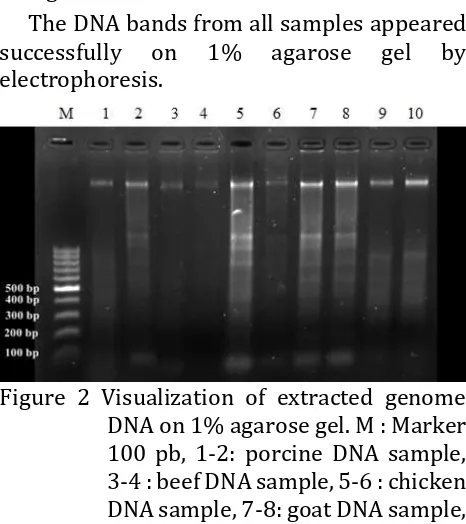DNA EXTRACTION METHOD FOR MOLECULAR DETECTION
METODE EKSTRAKSI DNA UNTUK DETEKSI MOLEKULER
R Hutami1a, N Idzni1, R Ranasasmita2, and M Suprayatmi1
1 Food Technology and Nutrition Department, Faculty of Halal Food Science, Djuanda University,
Indonesia.
2 The Assessment Institute for Foods, Drugs and Cosmetics, the Indonesian Council of Ulama, Indonesia
a Correspondence: Rosy Hutami, E-mail: [email protected]
(Diterima: 09-08-2017; Ditelaah: 10-08-2017; Disetujui: 26-10-2017)
ABSTRACT
In molecular detection technique such as Loop-Amplification Mediated Polymorphism (LAMP)
and Polymerase Chain Reaction (PCR), right upstream preparation of deoxyribonucleic acid
(DNA) is very important. Liquid phase extraction and solid phase extraction are some of DNA
extraction methods those are available. The purpose of this research was to characterizedthe
method and product of DNA extraction based on DNA purity, DNA visualization, DNA
concentration, and processing time of DNA extraction methods. Extraction methods evaluated
included phenol-chloroform method (Method A)as liquid phase extraction and Surefood
Extraction kit method (Method B) as solid phase extraction. Result showed that Method A could
be performed on samples with very low DNA concentrations ranging from 7.00 to 9.45 ng/µl
with a good purity (1.80 to 2.10). Although, it showed no DNA isolates bands on gel agarose 1%
and need ± 30 hours processing time. Method B had a good performa in extracting sample with
high concentration DNA (49.67 to 357.28 ng/µl) with a good purity (1.93 to 2.07). This method
showed bands for each DNA samples on gel agarose 1% and need about ± 1 hour processing
time. Both methods can be used for sample preparation in molecular analysis including halal
authentication purposes.
Keywords: phenol, chloroform, Surefood kit, LAMP.
ABSTRAK
Dalam teknik deteksi molekuler seperti Loop-Amplification Mediated Polymorphism (LAMP) dan
Polymerase Chain Reaction (PCR), pembuatan hulu asam deoksiribonukleat (DNA) sangat
penting. Ekstraksi fase cair dan ekstraksi fasa padat merupakan beberapa metode ekstraksi DNA
yang tersedia. Tujuan dari penelitian ini adalah untuk mengkarakterisasi metode dan produk
ekstraksi DNA berdasarkan kemurnian DNA, visualisasi DNA, konsentrasi DNA, dan waktu
pemrosesan metode ekstraksi DNA. Metode ekstraksi yang dievaluasi meliputi metode
fenol-kloroform (Metode A) sebagai ekstraksi fasa cair dan metode Ekstraksi Surefood kit (Metode B)
sebagai ekstraksi fasa padat. Hasil penelitian menunjukkan bahwa Metode A dapat dilakukan
pada sampel dengan konsentrasi DNA sangat rendah berkisar antara 7,00 sampai 9,45 ng / μl
dengan kemurnian yang baik (1,80-2,10). Meski tidak menunjukkan DNA isolat band pada gel
agarosa 1% dan membutuhkan waktu pemrosesan ± 30 jam. Metode B memiliki performa yang
baik dalam mengekstraksi sampel dengan DNA dengan konsentrasi tinggi (49,67 sampai 357,28
ng / μl) dengan kemurnian yang baik (1,93 sampai 2,07). Metode ini m
enunjukkan band untuk
setiap sampel DNA pada gel agarose 1% dan membutuhkan waktu ±1 jam. Kedua metode
tersebut dapat digunakan untuk preparasi sampel dalam analisis molekuler termasuk tujuan
otentikasi halal.
DNAbased on gel electrophoresis was shown
as Figure 2.
The DNA bands from all samples appeared
successfully
on
1%
agarose
gel
by
electrophoresis.
Figure 2 Visualization of extracted genome
DNA on 1% agarose gel. M : Marker
100 pb, 1-2: porcine DNA sample,
3-4 : beef DNA sample, 5-6 : chicken
DNA sample, 7-8: goat DNA sample,
9-fish DNA sample.
2.07.DNA isolates can be said to be pure and
have met the requirements for molecular
analysis when the ratio
λ
260/280ranges from
1.8 to 2.0
3,4
. DNA has maximum absorption in
λ
260 and protein has maximum absorption in
λ
280. So that, the products of both DNA
extraction methods can be used for molecular
analysis.
DNA Visualization
In method A, the DNA bands from the porcine
positive control extraction were successfully
visible on 1% agarose gel, but the DNA bands
from the fifth samples did not present. The
isolate DNA from fifth samplesthat did not
present on the gel can be caused by very small
amounts of DNA (<50 ng/
μl).
But, the
appearance of band of porcine positive
control and total DNA purity within the
normal range indicates that the
phenol-chloroform method can be used for molecular
analysis especially in sample with low DNA
concentration.
In method B, bands appeared in all of
samples well, although they had a various
thickness. The various band thickness can be
cause of different concentration of DNA.
Athick or dense and solid DNA band showed a
high concentration and good integrity of
DNA
5
. It was also showed DNA smear in
sample gel agarose visualization.DNA smear
showed that DNA was broken/sheared during
extraction process
5
.
DNA Concentration
DNA isolation resulted in varying yield from
7.00 to 9.45 ng/µl in method A and 49.67 to
357.28 ng/µl in method B of DNA
concentration. This yield is determined by
DNA
isolation
time
and
lysis
buffer
composition. Timing is essential since if it
takes too long, there is possibility of DNA
precipitation
6
.DNA concentration of the
extraction products were not uniform.
Therefore, the concentration of DNA that has
been obtained is uniformed by dilution, thus
DNA needs to be diluted to a certain level
concentration.
The
suggested
DNA
concentration is 10 ng to
1 μg DNA per μl for
PCR reaction
7
.
Method Principles
Method A

